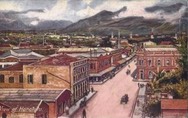Timeline of Immigrants to Hawaii1
Other information of importance added to the timeline and footnoted accordingly, as I find them.
300 - 700 AD: The first immigrants to Hawaii were the Pacific Islanders who arrived from the Marqueses Islands (part of French Polynesia today). Many years later, settlers from Tahiti arrived and conquered the original inhabitants of Hawaii. There are no written records of the arrivals, just theories historians throw about. Some think that think that the first settlers arrived in 300 AD and then sometime later another group from Tahiti arrived in about 700 AD. Others think that settlers arrived from several different Polynesian Ialand groups in a seady stream over a period of hundreds of years.
1700s: Chinese Sailors arrived on two fur trading ships, the Iphegenia (in 1788) and the North West America (in 1789). They were transient, but it is noted that throughout the 1700’s there were few Chinese permanently living in Hawaii.
1778: Jan 1778, arrival of Captain Cook in Waimea Bay, Kauai.
1779: 14 Feb 1779, Captain Cook killed in Kealakekua, Big Island.
1782: King Kamehameha I, reign Jul - 8 May 1819. Birth 1736 Kohala, Hawaiʻi Island. Established the Kingdom of Hawaiʻi in 1810 by developing alliances with the major Pacific colonial powers.
1784: Official account of Cook’s voyage published in three volumes.
1787: First Hawaiians travel to the Pacific NW.
1819: King Kamehameha II, reign 21 May - 1824. Gave up his father’s monopoly on sandalwood trade; placed the land under a new kapu system that allowed men and women freedom to eat together and eat foods in the past kapu to them5; allowed the first Missionaries to arrive in 1820 (by advisement of John Young).
1820: 30 Mar, first Missionaries arrive on the Thaddeus from the New England area. List of missionaries to Hawaii
1824: King Kamehameha III, reign 1824 - 1854. Established the declaration of rights (1839), Hawaii’s first constitution in 1840, judicial and executive brances of government, and a system of land ownership under the Mahele of 1848.
1826: Written Hawaiian language introduced by the American missionaries
1831: Lahainaluna, seminary for young men founded4.
1833: 10 January Oahu Charity School opened to educate the children of Caucasian sailor and Hawaiian women. The school was moved several times and changed names four times, the school still exists today and is called Pohukaina School4.
1835: First successful attempt at milling sugar began at Køloa, Kaua’i.2
1848: The Great Måhele that established land ownership for the first time. Land was divided among King Kamehameha III and 245 chiefs. By 1850, through subsequent acts, native commoners and foreigners were able to own land in fee simple. This enabled the haole businessmen to purchase land to set up plantations in order to grow sugar on a large scale. Labor was a big problem. The Native Hawaiians were lured to the Mainland by the Gold Rush, and now that the Native Hawaiians could own land, some preferred to cultivate their own kuleana (property). Compounding the problem was the fact that thousands of Hawaiians were dying from diseases introduced by foreigners.2
1850: The Masters and Servants’ Act was passed by the Hawaiian government. This established the legal basis for the contract labor system. This act became the basis upon which labor was supplied to the plantations for the next fifty years.2
1852: The first Chinese Plantation Workers arrived from Amoy, Fukien, China on 3 Jan 1852 on the Ship Thetis. Several ships followed bringing more laborers from China’s impoverished southern provinces. By the 1880’s there were more then 25,000 Chinese immigrants working on Hawaii’s sugar plantations. In 1883, the Kingdom of Hawaii limited the number of Chinese immigrants to 600 in any consecutive 3month period. Hawaii became a territory of the United States in July of 1898. By the early 1900s the United States Chinese Exclusion Act was extended to cover the new US Territories of Hawaii, the Philippines. Chinese immigration to Hawaii was halted until the Chinese Exclusion Act was repealed in 1943.
1854: King Kamehameha IV reign 1854 - 1863. Born Alexander Liholiho, adopted by King Kamehameha III, older brother of Victoria Kamamalu, brothers David, Moses, and Lot; married Emma Naea Rooke 1856; established the Queen’s Hospital in 1859.
1868-1924: Japanese Immigation to Hawaii as laborers for the plantation. In 1868 about 150 Japanese contract laborers arrived in Hawaii. Unlike the Japanese who arrived in 1885 and later, these men and women were not farmers. They did not know what working in the cane fields really meant and they were very unhappy with their treatment. The Hawaiian Kingdom and the Japanese Government reached an agreement two years later for these workers to return to Japan. Only about 40 took advantage and returned to Japan. The others chose to remain in Hawaii. In 1885, after resolving issues related to treatment of Japanese workers in Hawaii, the first major immigration from Japan began. By 1893, nearly 70% of the plantation workers in Hawaii were Japanese. In 1894, private companies were allowed to recruit Japanese laborers for Hawaii. Between 1894 and 1900, another 57,000 more Japanese arrived in Hawaii. By 1902 there were more than 30,000 Japanese plantation workers in Hawaii. In 1908, a “Gentlemen’s Agreement” restricted Japanese immigration to the United States. Between 1885 and 1924, about 100,000 Japanese had immigrated to Hawaii, most of them to work on the sugar plantations. In 1924, the United States prohibited further immigration from Japan.
1863: King Kamehameha V (Prince Lot) reign 1863 - 1872. Older brother of Kamehameha IV; promoted the cattle industry in Hawaiʻi; served as president of the graziersʻ association, and founded Molokaʻi Ranch; refused to legalize hard liquor and limited activities that would further erode the traditional agricultural lifestyle; unmarried and hei Victoria Kamamalu predeceased him; 1872 asked Bernice Pauahi Bishop to take the throne but she declined.
1868: First Japanese immigration to Hawaii. The "gannenmono" as they were called arrived in 1868, the first year of the reign of Emperor Meiji. The recruitment process was a little flaky and the "gannenmono" were hardly prepared to cope with sugar plantation work. Allegations of brutal treatment and expresions of dissatisfaction with low pay and high prices for essential goods led to the Meiji government to send an official to investigate conditions in Hawai'i. In an agreement reached on January 11, 1870, 40 "gannenmono" returned to Japan at the Meiji government expense. The remaining 108 elected to stay. Most were assimilated into the Hawaiian population. The experience left an unhappy memory for the Meiji government and further emigration of Japanese laborers were suspended.
1873: William Charles Lunalilo reign 1973 - 1974. Burried on the grounds of Kawalahaʻo Church; left his property to establish Lunalilo Home, a haven for poor, elderly and infirm Hawaiians.
1874: King David Kalakaua reign 1874 - 1891. Kalakaua was not related to the Kamehameha line but his father Kapaakea was the great grandson of Kameeiamoku, one of Kamehameha Iʻs strongest supporters; secured a reciprocity trade treaty with the United States; built Iolani Palace in 1879; signed the Bayonet Constitution in 1887; named his sister, Liliʻuokalani as heir and regent in his absence after his younger brother, William Pitt Leleiohoku died in 1877.
1877: The first Portuguese contract laborers came to Hawaii from the Azores and the Madeira Islands between 1877 and 1884. By 1884 there were nearly 10,000 Portuguese workers in Hawaii and by the early 1900’s there were 15,000.
1880: A group of about 600 Norwegians arrived to work for Castle and Cook.
1881: March 1881, King Kalakaua while on his trip around the world met with Emperor Meiji and made the following proposals. First, he proposed a marriage between his niece, Princess Ka`iulani and Japan's Prince Komatsu Second, King Kalakaua encouraged the Japanese to consider establishing economic colonies in Hawai`i , joining with Hawai`i in a "Union and Federation of Asiatic Nations and Sovereigns" to maintain their footing against those powerful nations of Europe and America, and to establish their independence and integrity in furture." Finally, he suggested that Hawai`i become the first nation to give up extraterritorial rights in Japan. All of the proposals were declined by the Japanese, but the expression of friendship provided a way for the resumption of emigration to Hawai`i6.
1881: The first 128 German workers and their families (21 families) arrived on the Cedar in 18 Jun 1881 from Bremen. 1882, the Iolani brought another 200 more workers and their families. 1883, Ehrenfels brought more than 800 passengers. German immigrants continued to arrive until 1897.
1891: Queen Liliʻuokalani (Lydia Paki) reign 1891 - 1895. Formally abdicated in 1895 to win clemency for the rebels who supported her; lived until 1917; author of Aloha ʻOe.
1893: Soon after the overthrow of the Hawaiian Monarchy, Hawaiian language taught in public school system was banned. The ban was officially lifted in 1986. The State of Hawaii recognized two official languages, Hawaiian and English, established by the State Contitution of 1978.
1894: 27 Jun, a US district court rules that Japanese immigrants cannot become citizens because they are not “a free white person” as the Naturalization Act of 1790 requires.3
1898: Hawaiʻi became a United States Territory.
1900: First immigrants from Okinawa arrived. Between 1900 and 1903 more than 8,000 laborers arrived in Hawaii. In 1946, after WWII, a new wave of Okinawans immigrated to Hawaii.
1900: The United States annexed Puerto Rico in 1898 and the first group of Puerto Ricans arrived in Hawaii in 1900. Eventually about 5,000 people immigrated fro Puerto Rico to Hawaii.
1903: The first 102 Korean contract laborers arrived in Hawaii on the S. S. Gaelic on 12 Jan 1903. Between 1903 to 1905 about 8,000 Koreans arrived. About that timeframe, the Korean government halted immigration to Hawaii because of reports that Korean workers were being mistreated in Mexico. Between 1910 to 1924 a second wave of Koreans immigrated to Hawaii. Includided in this group was about 700 picture brides. The 1924 Oriental Exclusion Act halted immigration. After WWII, immigration was again allowed. After the end of the Korean War in 1953, arrivals included many Korean brides of American servicemen and orphans adopted by American families.
1907: The first group of Spanish laborers immigrated to Hawaii from Malaga, Spain to work on Hawaii’s plantations.
1906: The first 15 Filipino men arrive in Hawaii to work on sugar plantations. In 1907 another 150 male Filipino workers arrived and the Hawaii Sugar Planters Association began establishing individual agreements with their Filipino workers which included employment terms. 1916, more than 18,000 Filipino workers immigrated to Hawaii to work on sugar plantations. 1934, the Tyding-McDuffie Act that paved the way for the Philippines to become an independent nation also restricted immigration of Filipinos to a quota of 50 per year. The second wave of Filipino immigration to Hawaii was in 1945; the third wave was in 1946. In 1965, a new group of Filipino immigrants arrived in Hawaii after a new immigration bill was signed by President Lyndon Johnson.
1908: New Immigration Act and the “Gentlemenʻs Agreement” restricted Japanese immigration to the United States to certain groups like former residents, their immediate family members, and persons with established farming interests.2 More information http://encyclopedia.densho.org/Gentlemen's_Agreement.
1908-1920: Arrival of the Japanese, Okinawan and Korean Picture Brides. About 20,000 women arrived in Hawaii in this timeframe to marry the single plantation workers.
1909: The Higher Wage Association strike that lasted 3 months. After the strike, conditions did improve.
1919: The National Prohibition Act established the legal definition of intoxicating liquors and prohibiting the sale of alcohol.
1920: 17 Jan the Filipino Labor Union went on strike; The Japanese Federation called a strike on 1 Feb. The Hawaii Laborersʻ Association, the successor to the Japanese Federation of Labor accepting in good faith the plantersʻ sincerity, surrendered and terminated the strike on 30 Jun. The strike cost the Japanese over $200,000 and the planters lost $12,000,000. Immediately after the end of the strike, wages were raised and improvements in working and living conditions.2
1920-1933: National Prohibition.
1924: Japanese Exclusion Act stopped all Japanese immigration to the United States.2
1952: 1 Jun, the Senate and House override Presient Trumanʻs veto and vote the McCarran-Walter Act into law. Among other effects, this bill granted Japan a token immigration quota and allowed Japanese immigrants to become naturalized US citizens.3 More information http://encyclopedia.densho.org/Immigration_Act_of_1952/
1959: 21 Aug, Hawaii becomes the 50th state.
__________________________
Footnote:
1. Hawaii for Visitors, Hawaii Travel Guide by Kathie Fry. Immigration to Hawaii by Ethnic Group
2. The Japanese in Hawai’i: Okage Sama De, Dorothy Ochiai Hazama and Jane Okamoto Kameiji, Bess Press, 3565 Harding Ave., Honolulu, HI, 1986, revised 2008, pp4-5,31,47-50,
4. The Companies We Keep 3: More Amazing Stories About Hawaii’s People, Places and Companies, Bob Sigall and his students at Hawaii Pacific University, Published by Small Business of Hawaii
5. The Hawaiian Kingdom - 1778-1884, University of Hawaii Press, 1938, R. S. Kuykendall, pp67-68
6. A Pictorial History of the Japanese in Hawai`i 1885-1924, pp14-17, Franklin Odo and Kazuko Sinoto, Hawai`i Immigrant Heritage Preservation Center, Department of Anthropology, Bernice Pauahi Bishop Museum, 1985
—————————————— Published Nov 2015 ——————————————


